(Editor’s note: This weekend the world celebrates the 105th running of the Indianapolis 500. Years ago we ran three features on major Porsche efforts at Indianapolis, and we’re re-running them today. While Porsche has had varying degrees of success at The Speedway in years gone by, we remain hopeful that one day the company will again expand its efforts into the greatest spectacle in motor racing. For now, please enjoy The First Porsche At Indianapolis, Politics Prevent Porsche Participation At 1980 Indy 500, and Porsche’s Project 2708 at Indy.)
After a public and politically charged exit from the 1980 Indianapolis 500, Porsche’s upper management vowed to stay out of the American open wheel racing scene for the foreseeable future. There was bad blood flowing between Porsche’s German upper management and that of the USAC sanctioning body after USAC changed the rules to limit Porsche’s 1980 attack, and Porsche then pulled the plug on the program. The experience had left a bad taste in Porsche’s mouth, and they weren’t looking to come back to the series anytime soon.
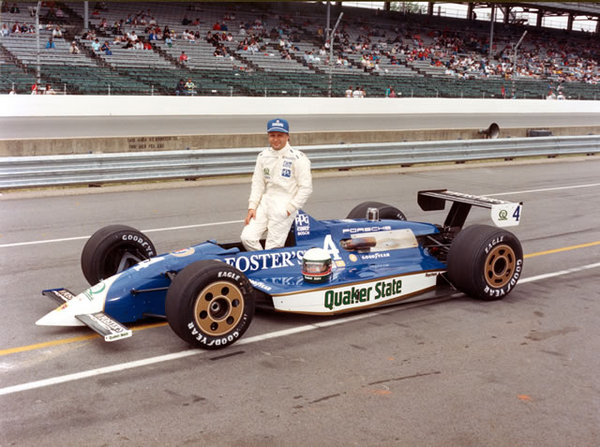
The famous Porsche – TAG – McLaren Formula 1 foray was the immediate result of pulling out of North American open wheel, as the engineering team now had the time and resources to pool in the creation of the new engine. I could write volumes in regards to the years between 1981 and 1987 when Porsche was building Formula 1 Turbocharged V6 engines, but what is important here is that the rule changes to be instituted in 1989 saw McLaren and TAG pulling away from their Porsche relationship and starting a new era with Honda engines. As it turns out, Honda was willing to give their engines to McLaren free of charge, so long as McLaren signed a young up-and-comer by the name of Ayrton Senna to the team. Porsche was only interested in supplying engines, rather than partnering with McLaren, so McLaren chose to move forward with Honda and the rest is history.
As the relationship with McLaren slowed down, Porsche’s then CEO, German-born American-raised Peter Schutz, was convinced to agree to a return to Indy by American head of motorsport, Al Holbert. As luck would have it, the maligned USAC sanctioning body had lost out in the battle for control of open wheel sanctioning to CART. Holbert had secured support from Quaker State Oil, and Schutz requested that the Porsche engineering department develop an engine and chassis from the ground up for the Indy effort. Among the final things accomplished under Schutz leadership, was the return of Porsche to North American open wheel competition with the Porsche Type 2708 (it turned its first wheel in competition just a month before Schutz was replaced by Heinz Branitzki).
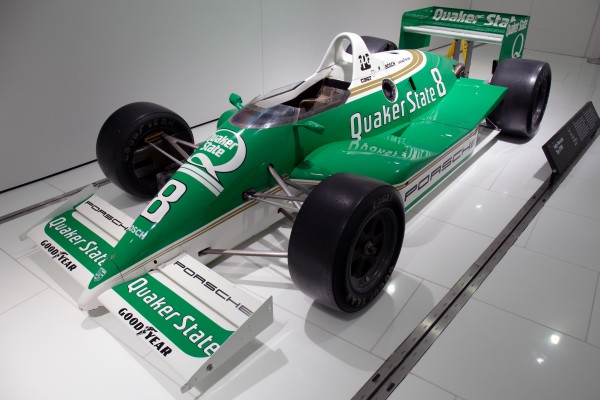
Unlike the 1980 “semi-works” effort, this time around, Porsche would be in control of the entire operation, truly creating a new factory team to work toward an Indy victory. Porsche assigned engine guru Hans Mezger to oversee creation of a new powerplant. Working from a TAG-Porsche engineering base, his team developed the new Indy engine into a 2.6-liter DOHC single-turbo V8 with Motronic management.
The responsibility of chassis development was handed to Norbert Singer. The 2708 chassis was built using information gained from Porsche’s last attempt at Indy in 1980. Unfortunately, while Porsche spent time away in Formula 1, the Indianapolis crowd had stepped up their game, and the 2708 chassis ended up being outdated, and overly bulky.
A Rocky Start With An Unfinished Chassis
Joining the 1987 CART season for the penultimate round at Laguna Seca, Al Unser Sr. demonstrated the flaws inherent in Type 2708 by qualifying third from the back and retiring early. A driver who wished to remain anonymous was quoted as saying “We expected Porsche to come over with a bullet-proof car, ready to move right up with the front-runners, I can’t believe they arrived so unprepared.” The final round of the season in Miami, Florida beleaguered all belief, as Unser abandoned the cause, and Holbert himself attempted to qualify the car, falling short of making the race. It was obvious, going into the winter off-season, that Porsche had a lot of work to complete in order to make a competitive car. Management decided that the best course of action was to use their engine in an already competitive chassis.
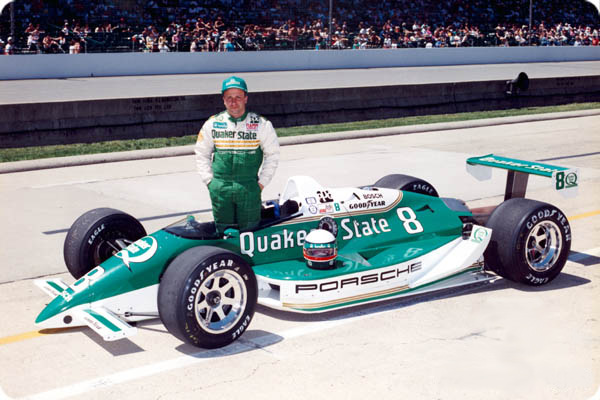
Project 2708 Given New Life With March-Designed Chassis
In the spring of 1988, Porsche strutted out a brand new March 88C tub with their engine reworked to fit in the back. Open wheel ace, Teo Fabi, was called upon for driving duties. Even though Fabi was considered the class of the field, as driving ability fares, the best finish he could scrape together that season was fourth place at Nazareth. The ’88 Indy 500 was not a good showing for the new Porsche-engined March, either. Fabi qualified 17th on the grid, but drama struck when he pitted under caution on lap 34. An unsecured rear wheel nut caused the wheel to separate and the car bottomed out, causing an incurable oil leak.
In October of 1988, the Porsche Indycar cause lost a major proponent in Al Holbert when he tragically died in a light aircraft accident. Without Holbert, there was no American voice for the team. Being run primarily by the Germans, there were few on the team who understood the dynamics of Indianapolis racing. As such, Brit Derek Walker was hired to consult in an effort to improve through 1989.
While the CART season was more successful for Porsche, with the improved March 89P underpinning an improved version of the turbocharged V8, the Indy 500 provided even less success than in 1988. In the month of May, at the Brickyard, Fabi managed to qualify 13th on the post, but ignition issues pulled the car out of contention after completing only 23 laps. A poor showing at the 500 was only punctuation on an otherwise healthy season, netting five fourth-place finishes, a third-place, a pair of seconds, and culminating in a victory for the team at the Mid-Ohio round of the series. Fabi finished the season sitting on fourth in the points standings, but the factory could only focus on the poor showing at Indy.
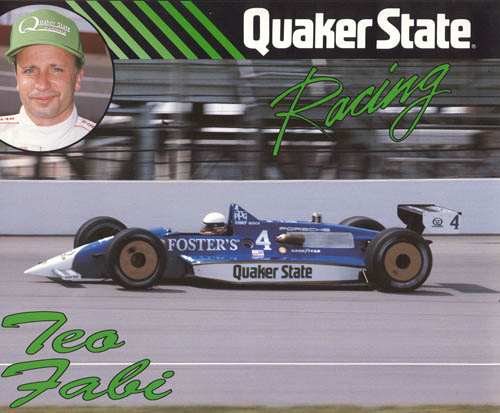
Politically Charged Chassis Changes Required For 1990
Showing promise for the 1990 season, Walker’s position as overseer brought about a second chassis for John Andretti to pilot. Things looked great for the team, as March’s new 90P chassis was developed around cutting edge carbon fiber composite monocoque technology, following the 1990 CART rulebook. Looking very svelte, the new chassis was nicknamed “the pancake” as it was very low to the ground, and the sidepods swung out to a wide curving arc on either side, framing the driver and engine in a large circular body.
Once the chassis design had entered the production phase, however, CART denied the new chassis an admission to run in the series for 1990. CART cited a fear for the safety of drivers as their primary concern, though it is said that the fits pitched by Lola Cars and Penske Racing were the real motivation. Penske was rumored to have begun development of a similar carbon monocoque, and was equally said to not be in a position to have it ready for the upcoming season. It is more than possible that USAC-like CART politics caused the carbon 90P chassis to suddenly become ineligible to compete, as later crash tests proved the chassis to be both lighter and safer than an aluminum tub.
March was able to recreate the chassis in a honey-comb aluminum monocoque, but testing was delayed until early the following year, and very little time remained pre-season to get the car dialed in, and Porsche had some issues packaging the engine in this new chassis. The new shape was ready for debut at the season opener in Phoenix, but offered little in the way of improvement that Porsche had hoped to see. In testing, the car was unresponsive to aerodynamic tweaks, and Fabi parked the car, frustrated and despondent. Andretti’s reaction to driving the car was generally positive, though stating that it still needed work. Dr. Ulrich Bez was quoted as having said “When you have to use the brakes in the corners at Phoenix it’s a clear sign that the chassis has to go back to the drawing board.” Sending March back to the drawing board on the 90 chassis, Porsche pressed a pair of 89P chassis back into service for the first two rounds at Phoenix and Long Beach.
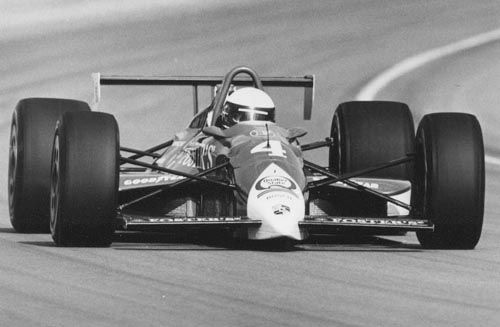
Heading into the 1990 Indy 500, Porsche found additional sponsorship with Foster’s Australian Lager, and the 90P was prepared to enter the race for both drivers. The car fared alright in qualifying, with Fabi making the race again in 23rd, and Andretti just breaking into the top 10. The race, however, was just as disastrous as had come to be commonplace with Porsche. Andretti brushed the outside wall exiting turn 4 on lap 135, and the resulting damage saw him lazily spin into the wall in turn 1, officially finishing 21st. Fabi led an uneventful race, which ended with a transmission failure on the 162nd lap, finishing in 18th position.
Lackluster 1990 Results Cause Porsche To Pull The Plug
The rest of the season showed promise, but lacked in outright results. During the Grand Prix on the streets of Detroit, the 90P’s packaging issues showed up again, with heat from the turbocharger causing the methanol in the nearby fuel pump to boil. Attempts to cool the pump were in vain, and both cars were forced to retire. The car seemed good for a short run, such as a few laps in qualifying, but long stints of running always brought out the gremlins inherent in the rushed design. Fabi even managed to capture a pole position in the Denver Grand Prix, but after running briefly at the front, the car’s brakes failed on lap 15 and he buried the nose of the car in the tire wall.
Similar to the 1961 Formula 1 season, Porsche had banked on previous years improvements as indicative of a promising season. Once those results did not arrive, the highs of a decent 1989 made the lows of 1990 feel even lower. At the end of the season, Porsche discontinued their uneventful 3 seasons and change of Indycar racing to focus, ironically, on development of a new naturally aspirated V12 Formula 1 engine for the Footwork Arrows team.
Since the end of the project at the end of the 1990 season, Porsche has stayed away from IndyCar racing altogether. With the new DW12 chassis introduced in 2012, there was some discussion of a return to the series, though nothing truly came of it. Whether we will ever see a P-car at the brickyard again, only time will tell. As it stands right now, this seems an unlikely proposition at any point in the near future. With that said, the North American market remains very important to Porsche sales, and there may come a day when the company sees fit to come back to open-wheeled motorsport.
Updated (11:43am EDT, 05/24/2021): Updated for 2021 Indy 500 feature with intro paragraph text.
Other Porsche Blog Posts You Will Enjoy
Politics Prevent Porsche’s Participation At 1980 Indy 500
The First Porsche at Indianapolis
A Night at the Museum With Karl Ludvigsen: Interview and Pictures
What It’s Like To Drive Nearly 200 MPH In The 835 HP Switzer-Built 997 Turbo “E911″
[Source: LA Times, October 1988 | 8W.com | AutoDesign.com Images: Porsche | Quaker State]
